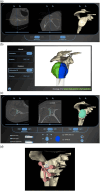Advanced technology in shoulder arthroplasty
- PMID: 39318404
- PMCID: PMC11418667
- DOI: 10.1177/17585732231188959
Advanced technology in shoulder arthroplasty
Abstract
Background: Glenoid component positioning is an important and challenging aspect of total shoulder arthroplasty. The use of freehand technique with standard instrumentation or preoperative planning based on 2-dimensional computed tomography (CT) scans provides an opportunity for improvement in terms of component accuracy, precision, and deformity correction. These techniques have produced varying outcomes.
Methods: Preoperative planning software (PPS), patient specific instrumentation (PSI), and intraoperative navigation (NAV) have been developed to improve the accuracy of implant placement and deformity correction with the ultimate goals of improved patient outcomes and implant longevity. Literature search was conducted on published and available studies comparing the accuracy of glenoid component placement and improvements in surgical and patient outcomes amongst the aforementioned techniques.
Results: PPS, PSI, and NAV have demonstrated improved accuracy over freehand techniques with standard instrumentation. However, data demonstrating the clinical benefit and cost effectiveness of these new technologies are lacking.
Discussion: In this paper, we reviewed the evidence available to answer the question of whether or not advanced shoulder arthroplasty technologies have been beneficial and reviewed future technologies in development such as virtual/mixed-reality and robotic assisted shoulder surgery.
Level of evidence: 4.
Keywords: anatomic; arthroplasty; augmented reality; computer assisted navigation; glenoid component; guide pin; patient specific instrumentation; preoperative planning software; reverse; robotic; shoulder; virtual reality.
© The Author(s) 2023.
Conflict of interest statement
JZ, MB, and JDZ conceived the initial idea for the review. JZ wrote the first draft. MB offered significant edits to the first draft. JDZ reviewed and made significant edits to reach the final draft. All authors reviewed and approve of the final draft. The author(s) declared the following potential conflicts of interest with respect to the research, authorship, and/or publication of this article: JDZ owns stock or stock potions with AposTherapy, Inc, Hip Innovation Technology; JDZ sits on the editorial or governing board of Clinical Orthopedics and Related Research; JDZ receives royalties as a design surgeon for Exactech, Inc.; JDZ is a paid consultant for Musculoskeletal Transplant Foundation; JDZ receives publishing royalties and financial or material support from SLACK Incorporated, Thieme, Inc., Wolters Kluwer health-Lippincott Williams & Wilkins; JDZ is an unpaid consultant for Gold Humanism Foundation and J3Personica/Residency Select. Other than the previously mentioned declarations, JDZ, their immediate family, and any research foundation with which they are affiliated did not receive any financial payments or other benefits from any commercial entity related to the subject of this article. MB, their immediate family, and any research foundation with which they are affiliated did not receive any financial payments or other benefits from any commercial entity related to the subject of this article. JRZ, their immediate family, and any research foundation with which they are affiliated did not receive any financial payments or other benefits from any commercial entity related to the subject of this article.
Figures




References
-
- Hoppenfeld S. Surgical Exposures in Orthopaedics: The Anatomic Approach. 5th ed. (Murphy D, eds). Philadelphia: Wolters Kluwer Health, 2017, 42–79.
-
- Strauss EJ, Roche C, Flurin P-H, et al. The glenoid in shoulder arthroplasty. J Shoulder Elbow Surg 2009; 18: 819–833. - PubMed
-
- Walch G, Badet R, Boulahia Aet al. et al. Morphologic study of the glenoid in primary glenohumeral osteoarthritis. J Arthroplasty 1999; 14: 756–760. - PubMed
-
- Matsen FA, III, Clinton J, Lynch J, et al. Glenoid component failure in total shoulder arthroplasty. J Bone Joint Surg Am 2008; 90: 885–896. - PubMed
Publication types
LinkOut - more resources
Full Text Sources
Research Materials
